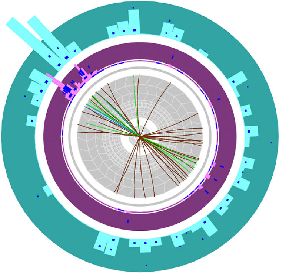Large Hadron Collider (LHC) in the European Center for Particle Physics CERN starts to produce relevant physics results. In heavy ion collisions physicists managed to evocate situation which is often popularly called Little Big Bang. After first publications mapping the basic characteristics (particle multiplicities, rapidity and momentum spectra, etc.) of proton-proton interaction in the region three-and-half times exceeding up to now achieved energies, LHC is coming with a result which literally has flown around the world and excited scientific community.
A significant di-jet asymmetry has been observed in the collisions of ultra-relativistic Pb nuclei with the energy of 2.76 TeV/nucleon analyzed with the help of the ATLAS apparatus operating on LHC accelerator at CERN. The effect is more pronounced with the rising centrality of the collision. Particle jets produced in nuclei collisions interact with the matter consisting of quarks and gluons.

Asymmetry of di-jets as observed in ATLAS: cross section of the ATLAS apparatus with visualized particle tracks and associated signals in calorimeters. The observed effect is a result of quenching of one of the jets due to it’s interaction with the quark-gluon matter.
The collision takes place in extremely short time less than 10-24 s at extremely high energies localised in a very small space. Such environment can be characterised by temperatures of the order of 1012 K (for comparison - the temperature in the Sun core is about 107 K) when quarks and gluons behave as free "particles" and form quark-gluon plasma. The observed effect is a result of the interaction of jet particles with extreme state of matter. The analysis of such effect makes it possible to study the physics of the particle formation and also properties of the quark-gluon plasma itself.
The Czech research institutions significantly participate in that unique scientific result. The Institute of Physics of the Academy of Sciences visibly contributed to the R&D and consequently to the construction of the Hadron Calorimeter of ATLAS, which principally improved the quality of the obtained result.
Reference:
PHYSICAL REVIEW LETTERS: PRL 105, 252303 (2010), 17 DECEMBER 2010
DOI: 10.1103/PhysRevLett.105.252303
Copyright © 2008-2010, Fyzikální ústav AV ČR, v. v. i.